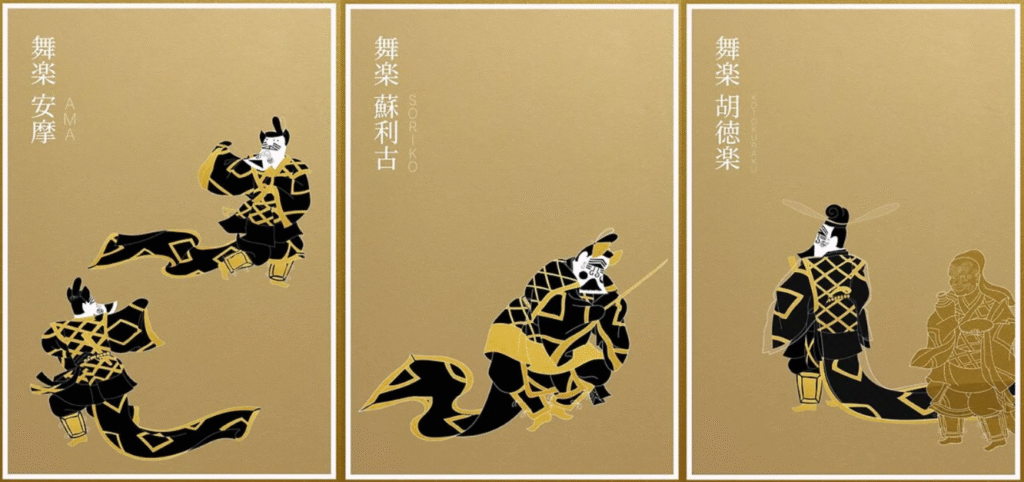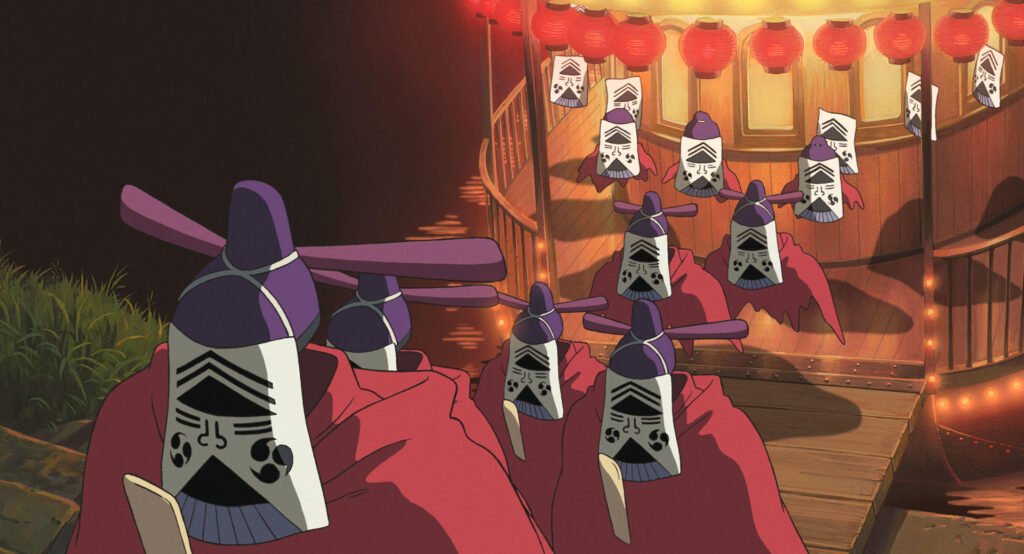Explore the mysterious world of Japanese Zomen masks, their ritual significance in traditional Bugaku dance, and their fascinating connection to ancient Japanese spirituality.
For readers who are not yet acquainted with Bugaku or Zomen, we offer a concise introduction in our previous article, “Unveiling the Mystery of Japanese Mask Design: The Art of Bugaku’s Zomen Masks”
Understanding Japanese Zomen Masks: A Basic Introduction
Japanese Zomen masks (also written as “zōmen”) represent one of the most intriguing yet lesser-known elements of traditional Japanese performing arts. Unlike the elaborately carved Noh or Kyogen masks, these simple fabric or paper masks feature minimalist facial designs yet carry profound cultural significance. These distinctive Japanese Zomen masks are primarily used in Bugaku—a form of ancient court dance and music that originated in the Nara period (710-794 CE).
The word “zomen” can be written with different kanji characters in Japanese: 雑面 (miscellaneous mask), 藏面 (storage mask), or 造面 (constructed mask)—each suggesting different aspects of their nature and purpose. These Japanese Zomen masks are particularly notable in performances of dances called “Ama” and “Soriko,” gaining recognition even among contemporary audiences through similar motifs appearing in Hayao Miyazaki’s acclaimed film “Spirited Away.”
The Ritual Power of Japanese Zomen Masks: Evidence from Shitennoji Temple
The use of Japanese Zomen masks in ritual contexts reveals their deeper spiritual significance. According to research by Makoto Ono (2011) concerning the Shoryoe ceremony at Shitennoji Temple in Osaka, these masks were believed to possess extraordinary powers.
At Shitennoji Temple, the dance called “Soriko,” which traditionally requires four dancers, is uniquely performed by five dancers during the Shoryoe ceremony. The performers wear Japanese Zomen masks made of paper with mysterious facial designs. Similarly, another dance called “Ama” uses these masks and is performed to pacify the earth deities through magical powers. This suggests Japanese Zomen masks were considered vehicles of supernatural efficacy.
Historical records from “Shitennoji Hojiki” (Records of Ceremonies at Shitennoji) indicate that after ritual ceremonies, only the dancers wearing Japanese Zomen masks received special portions of the offerings alongside high-ranking officials. This exceptional treatment demonstrates the sacred status accorded to these masked performers. Some traditions even suggest these masks possessed the power to awaken the spirit of Prince Shotoku, one of Japan’s most revered historical figures, indicating their profound religious importance.
Ono, Makoto. “Thinking from Osaka: The Splendor of Shitennoji Temple’s Shoryoe Ceremony.” Annual Research Report of the Humanities Research Institute of Soai University 5 (2011): 15-24.
Origins of Japanese Zomen Masks: Connection to Nara Period Artifacts
The study of Japanese Zomen masks inevitably leads to the examination of “Nunome” (fabric masks) preserved in the Shosoin Imperial Repository in Nara. In his comprehensive work “History of Japanese Masks” (1943), scholar Seiroku Noma introduces an intriguing theory by Professor Naoo Tanabe regarding the origin of these masks.
Tanabe proposed that the Ama dance represented Indian earth deities and featured aboriginal inhabitants, with female masks depicting leprosy. He suggested that Japanese Zomen masks symbolized faces covered with white cloth to prevent disease transmission, with openings for eyes and nostrils visible through the fabric. While an interesting hypothesis, Noma considered it more plausible that the simpler Japanese Zomen masks were practical substitutes for more elaborate masks.
Noma, Seiroku. “History of Japanese Masks” Geibun Shoin 1943
The Shosoin Repository’s official documentation offers detailed descriptions of these ancient fabric masks. The eye openings vary significantly—some feature small holes just for the pupils, others have openings following the entire eye contour, and some have elongated slits beneath the eyes. The mouth areas also differ, with some having vertical slits, others with openings on the left side, and some with no openings at all.
Researchers believe these variations served practical purposes. The vertical mouth slits likely accommodated vertical flutes or the Japanese reed instrument called shō, while side openings accommodated transverse flutes. Masks without openings were probably worn by string instrument players or percussionists. These modifications suggest that Japanese Zomen masks were customized by the performers themselves for practical performance needs—essentially serving as ancient “cosplay” for Tang Dynasty-style court musicians.
Cultural Context: Adaptation of Foreign Arts into Japanese Tradition
The evolution of Japanese Zomen masks beautifully illustrates Japan’s cultural propensity for adopting foreign elements and transforming them into distinctly Japanese forms. Originally introduced from China and the Korean Peninsula as part of gagaku court music, the fabric masks gradually evolved into the unique Japanese Zomen masks that became integral to indigenous ceremonies and aesthetic sensibilities.
Particularly noteworthy is the design philosophy behind Japanese Zomen masks. Rather than striving for realistic representation like the detailed Noh masks, they embrace simplicity. Their minimalist facial expressions paradoxically enhance their mystical quality, stimulating the viewer’s imagination. This “suggestion through omission” exemplifies a fundamental principle of Japanese aesthetics, with Japanese Zomen masks standing as prime examples of this artistic approach.
Contemporary Relevance of Japanese Zomen Masks
In modern times, Japanese Zomen masks transcend their historical context to become relevant cultural artifacts. As previously mentioned, their mysterious design has influenced contemporary popular culture, including internationally acclaimed anime films like “Spirited Away.”
Beyond entertainment, Japanese Zomen masks offer valuable insights into the universal themes embodied by masks across cultures—the interplay between self and other, revelation and concealment, sacred and profane boundaries. Despite their technical simplicity, these Japanese Zomen masks carry profound symbolic weight, perhaps asking us to reconsider what constitutes essential elements of human expression in our increasingly complex society.
Conclusion
The investigation into Japanese Zomen masks reveals how seemingly simple cultural artifacts can contain multifaceted histories and meanings. Originating from the Nara period “Nunome” and evolving through religious rituals and artistic performances, Japanese Zomen masks symbolize Japan’s cultural history of adaptation and transformation.
For scholars and cultural enthusiasts interested in further exploration, searching variations of the term—”zomen,” “zōmen,” or the Japanese kanji variants (雑面, 藏面, 造面)—can uncover additional research avenues. Valuable references include “History of Japanese Masks,” “Great Dictionary of Japanese Literature, Volume 3,” and “Illustrated Explanation of Bugaku in the Collection of Historical Practices.”
These enigmatic faces rendered on simple fabric or paper—Japanese Zomen masks—continue to captivate our imagination across more than a millennium, offering a window into Japan’s rich cultural heritage and aesthetic philosophy.
Explore More Free Downloadable Resources
If you’re interested in discovering more freely downloadable historical Japanese art resources for your creative projects, click the banner below. Our curated collection includes additional ukiyo-e prints, kimono pattern books, and rare illustrated manuscripts that offer authentic glimpses into Japan’s artistic heritage. Continue your journey through the floating world and beyond with these carefully selected visual treasures from Japan’s golden age of woodblock printing.





